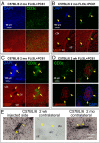Exogenous fms-like tyrosine kinase 3 ligand overrides brain immune privilege and facilitates recognition of a neo-antigen without causing autoimmune neuropathology
- PMID: 20660723
- PMCID: PMC2922551
- DOI: 10.1073/pnas.0913496107
Exogenous fms-like tyrosine kinase 3 ligand overrides brain immune privilege and facilitates recognition of a neo-antigen without causing autoimmune neuropathology
Abstract
Soluble antigens diffuse out of the brain and can thus stimulate a systemic immune response, whereas particulate antigens (from infectious agents or tumor cells) remain within brain tissue, thus failing to stimulate a systemic immune response. Immune privilege describes how the immune system responds to particulate antigens localized selectively within the brain parenchyma. We believe this immune privilege is caused by the absence of antigen presenting dendritic cells from the brain. We tested the prediction that expression of fms-like tyrosine kinase ligand 3 (Flt3L) in the brain will recruit dendritic cells and induce a systemic immune response against exogenous influenza hemagglutinin in BALB/c mice. Coexpression of Flt3L with HA in the brain parenchyma induced a robust systemic anti-HA immune response, and a small response against myelin basic protein and proteolipid protein epitopes. Depletion of CD4(+)CD25+ regulatory T cells (Tregs) enhanced both responses. To investigate the autoimmune impact of these immune responses, we characterized the neuropathological and behavioral consequences of intraparenchymal injections of Flt3L and HA in BALB/c and C57BL/6 mice. T cell infiltration in the forebrain was time and strain dependent, and increased in animals treated with Flt3L and depleted of Tregs; however, we failed to detect widespread defects in myelination throughout the forebrain or spinal cord. Results of behavioral tests were all normal. These results demonstrate that Flt3L overcomes the brain's immune privilege, and supports the clinical development of Flt3L as an adjuvant to stimulate clinically effective immune responses against brain neo-antigens, for example, those associated with brain tumors.
Conflict of interest statement
The authors declare no conflict of interest.
Figures





Similar articles
-
Prophylactic treatment with fms-like tyrosine kinase-3 ligand after burn injury enhances global immune responses to infection.J Immunol. 2008 Mar 1;180(5):3038-48. doi: 10.4049/jimmunol.180.5.3038. J Immunol. 2008. PMID: 18292526
-
Dendritic cells engineered to express the Flt3 ligand stimulate type I immune response, and induce enhanced cytoxic T and natural killer cell cytotoxicities and antitumor immunity.J Gene Med. 2003 Aug;5(8):668-80. doi: 10.1002/jgm.387. J Gene Med. 2003. PMID: 12898636
-
Fms-like tyrosine kinase 3 ligand controls formation of regulatory T cells in autoimmune arthritis.PLoS One. 2013;8(1):e54884. doi: 10.1371/journal.pone.0054884. Epub 2013 Jan 21. PLoS One. 2013. PMID: 23349985 Free PMC article.
-
Fms-like tyrosine kinase 3 ligand-dependent dendritic cells in autoimmune inflammation.Autoimmun Rev. 2014 Feb;13(2):117-24. doi: 10.1016/j.autrev.2013.09.010. Epub 2013 Oct 7. Autoimmun Rev. 2014. PMID: 24113138 Review.
-
Evolutionary basis of a new gene- and immune-therapeutic approach for the treatment of malignant brain tumors: from mice to clinical trials for glioma patients.Clin Immunol. 2018 Apr;189:43-51. doi: 10.1016/j.clim.2017.07.006. Epub 2017 Jul 15. Clin Immunol. 2018. PMID: 28720549 Free PMC article. Review.
Cited by
-
Improved Adeno-associated Viral Gene Transfer to Murine Glioma.J Genet Syndr Gene Ther. 2013 Apr 29;4(133):12815. doi: 10.4172/2157-7412.1000133. J Genet Syndr Gene Ther. 2013. PMID: 24319629 Free PMC article.
-
Isolation and Flow Cytometric Analysis of Glioma-infiltrating Peripheral Blood Mononuclear Cells.J Vis Exp. 2015 Nov 28;(105):53676. doi: 10.3791/53676. J Vis Exp. 2015. PMID: 26650233 Free PMC article.
-
The Spleen as an Optimal Site for Islet Transplantation and a Source of Mesenchymal Stem Cells.Int J Mol Sci. 2018 May 7;19(5):1391. doi: 10.3390/ijms19051391. Int J Mol Sci. 2018. PMID: 29735923 Free PMC article. Review.
-
Functional characterization of tumor antigen-specific T-cells isolated from the tumor microenvironment of sleeping beauty induced murine glioma models.Methods Enzymol. 2020;631:91-106. doi: 10.1016/bs.mie.2019.05.032. Epub 2019 Jun 8. Methods Enzymol. 2020. PMID: 31948569 Free PMC article.
-
Gene therapy and virotherapy: novel therapeutic approaches for brain tumors.Discov Med. 2010 Oct;10(53):293-304. Discov Med. 2010. PMID: 21034670 Free PMC article. Review.
References
-
- Mrass P, Weninger W. Immune cell migration as a means to control immune privilege: Lessons from the CNS and tumors. Immunol Rev. 2006;213:195–212. - PubMed
-
- Arck PC, Gilhar A, Bienenstock J, Paus R. The alchemy of immune privilege explored from a neuroimmunological perspective. Curr Opin Pharmacol. 2008;8:480–489. - PubMed
-
- Galea I, Bechmann I, Perry VH. What is immune privilege (not)? Trends Immunol. 2007;28:12–18. - PubMed
-
- Lowenstein PR. Immunology of viral-vector-mediated gene transfer into the brain: An evolutionary and developmental perspective. Trends Immunol. 2002;23:23–30. - PubMed
-
- Perry VH. A revised view of the central nervous system microenvironment and major histocompatibility complex class II antigen presentation. J Neuroimmunol. 1998;90:113–121. - PubMed
Publication types
MeSH terms
Substances
Grants and funding
LinkOut - more resources
Full Text Sources
Medical
Molecular Biology Databases
Research Materials
Miscellaneous

